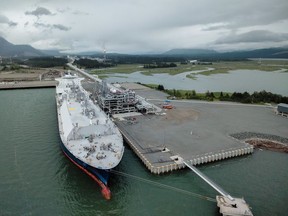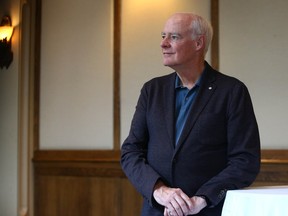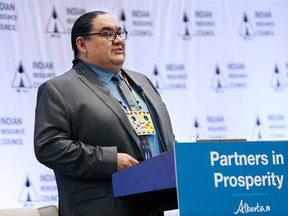Varcoe: Carney government needs 'quick wins' from energy projects and to address internal challenges on Bill C-5, says new report'We have a tremendous competitive resource when the government isn't blocking it,' said report co-author Heather Exner-Pirot
Published Jul 21, 2025
Last updated 14 hours ago5 minute read
 The GasLog Glasgow at LNG Canada’s berth in Kitimat, B.C. Photo by Handout/LNG Canada The GasLog Glasgow at LNG Canada’s berth in Kitimat, B.C. Photo by Handout/LNG Canada
The Carney government needs to put some “quick wins” under its belt and advance major energy projects of national importance, but also address challenges created by “compressed timelines” under its new Bill C-5 and deepen Indigenous engagement, says a new report.
A white paper by members of the Expert Group on Canada-U.S. Relations says significant energy sector proposals should be high on Ottawa’s major projects list, including oil and gas developments, nuclear, hydrogen and renewable infrastructure.
Bill C-5 was passed by the Carney government in June and aims to fast-track initiatives deemed to be in the national interest, such as ports, critical mineral developments, economic corridors and liquified natural gas (LNG) terminals.
Headline News
Get the latest headlines, breaking news and columns.
By signing up you consent to receive the above newsletter from Postmedia Network Inc.
The next six months will be critical for the legislation’s success and the federal cabinet should designate “low-risk, high-impact” priority projects to expedite through the approval process, says the study, to be released Monday.
“Ultimately, it will be crucial to achieve some early successes to establish support for the process and maintain momentum. The government will also need to quickly develop a couple of projects that have the potential to be quick wins,” it states.
“Bill C-5 marks a potential turning point in Canada’s approach to nation-building projects . . .
“With discipline, focus, and genuine Indigenous partnerships, Canada can seize this moment to deliver over $100 billion in investment, 50,000-plus jobs, and a resilient, cleaner energy future.”
The bill was adopted as Canada faces tariffs from the U.S. administration, which has sparked a renewed focus on increasing this country’s ability to increase its exports with other nations, as well as attract more investment.
Alberta Premier Danielle Smith and oilpatch leaders want to see ambitious new energy projects included on the federal list, including an oil pipeline to the Pacific Coast and new LNG export facilities.
“For too long, we’ve been a country of builders that can’t get anything built, and we have acted ashamed of our own resource inheritance at a time when the world is desperate for what we can produce,” said Perrin Beatty, co-chair of the group and former CEO of the Canadian Chamber of Commerce.
This advertisement has not loaded yet, but your article continues below.
“This is an existential moment for Canada where we have both an opportunity and an obligation to become both more prosperous and more sovereign.”
 Hon. Perrin Beatty, President and CEO of the Canadian Chamber of Commerce, chats with Postmedia during the 2022 Global Business Forum in Banff, Alta. on Friday, Sept. 23. Jim Wells/Postmedia Hon. Perrin Beatty, President and CEO of the Canadian Chamber of Commerce, chats with Postmedia during the 2022 Global Business Forum in Banff, Alta. on Friday, Sept. 23. Jim Wells/Postmedia
Prime Minister Mark Carney told the Calgary Herald recently it is “highly likely” an oil pipeline to the Pacific Coastwill be included on the federal list, although he said it will be up to private sector proponents to drive any proposal.
The report calls Bill C-5 a “welcome transformative step” as it will allow Ottawa to streamline the authorization of major projects and approve them within two years, co-ordinated by a single federal office. It will also help meet the growing need for energy in the world.
“There is low-hanging fruit. Some things are ready to go . . . Time is ticking,” report co-author Heather Exner-Pirot said in an interview.
“Let’s start seeing some action. Let’s start seeing some projects.”
If the changes under Bill C-5 had been in place for three energy projects that were completed earlier this decade — the Trans Mountain expansion, LNG Canada and the Coastal GasLink pipeline — it would have been valuable, but led to a “relatively modest” average time savings of 1.5 years, the study notes.
These findings highlight the need to address challenges early in the development of a major project, it states.
Projects that should be on the list and can move quickly include the Ksi Lisims LNG project on the northwest B.C. coast, a second phase of LNG Canada, and steps to boost the capacity of Trans Mountain, said Exner-Pirot, who is also director of natural resources, energy and environment at the Macdonald-Laurier Institute.
 Heather Exner-Pirot of the Macdonald-Laurier Institute. Submitted photo Heather Exner-Pirot of the Macdonald-Laurier Institute. Submitted photo
However, the bill has sparked some criticism about the impact of speeding up the approval process, and Carney met with First Nations leaders last week and heard some of their concerns with Bill C-5.
“Free, prior and informed consent on First Nations Lands is non-negotiable. An advisory role is inadequate for real partnership,” Grand Chief Greg Desjarlais of the Confederacy of Treaty 6 First Nation said Friday in a news release.
“I will trust actions over words as we look to move forward.”
To mitigate risks and concerns about an expedited approval process, Ottawa needs to “deepen Indigenous engagement . . . to ensure genuine, equitable partnerships and meaningful participation,” states the report from the Expert Group on Canada-U.S. Relations, which includes academics, energy experts and business leaders.
“Consultation should begin as early as possible and continue throughout the project lifecycle.”
The report says Ottawa should launch a formal process surrounding co-developing benefit-sharing and equity ownership agreements with Indigenous communities for major projects. It recommends transparent standards for consultation, such as timelines and public disclosure of the outcomes.
“Meaningful consultation with First Nations and Indigenous groups is both a practical and legal necessity. The prime minister was clear (last week) in stating that he understood this reality, but the follow-through will be vital,” Beatty said in an e-mail.
Equity ownership in major energy projects is a huge economic opportunity for some Indigenous communities, but Bill C-5 will require a lot of work from Ottawa, said Stephen Buffalo, chair of the Alberta Indigenous Opportunities Corp. and CEO of the Indian Resource Council of Canada.
“It’s going to take a lot of consultation, and I think we all need to work together on this,” said Buffalo. “If Canada is going to be a superpower, it’s going to be with First Nations, which is pretty exciting, in my view.”
 Stephen Buffalo is President and Chief Executive Officer of the Indian Resource Council of Canada.Photo by Gavin Young /Postmedia Network Stephen Buffalo is President and Chief Executive Officer of the Indian Resource Council of Canada.Photo by Gavin Young /Postmedia Network
It’s imperative that the federal government continue the momentum that has seen some Indigenous communities become equity owners in major natural resource projects in recent years, said Exner-Pirot.
It’s also important that Ottawa unleashes the energy sector, she added.
“We have a tremendous competitive resource when the government isn’t blocking it.”
The Carney government should publish a list of major projects within the next six months that includes many forms of energy, allocate new federal funds for cleaner energy initiatives, and articulate the benefits of projects to establish broad-based support, according to the report.
The study also discusses the role of potential government financial involvement in some higher risk projects such as hydrogen hubs or large-scale Arctic LNG terminals, through tax credits, targeted subsidies or loan guarantees.
It calls on Ottawa to “implement prudent financial risk management, prioritize projects with strong private sector backing and reserve government support when appropriate for high-risk, high-impact ventures.”
Chris Varcoe is a Calgary Herald columnist |





 The GasLog Glasgow at LNG Canada’s berth in Kitimat, B.C. Photo by Handout/LNG Canada
The GasLog Glasgow at LNG Canada’s berth in Kitimat, B.C. Photo by Handout/LNG Canada Hon. Perrin Beatty, President and CEO of the Canadian Chamber of Commerce, chats with Postmedia during the 2022 Global Business Forum in Banff, Alta. on Friday, Sept. 23. Jim Wells/Postmedia
Hon. Perrin Beatty, President and CEO of the Canadian Chamber of Commerce, chats with Postmedia during the 2022 Global Business Forum in Banff, Alta. on Friday, Sept. 23. Jim Wells/Postmedia Heather Exner-Pirot of the Macdonald-Laurier Institute. Submitted photo
Heather Exner-Pirot of the Macdonald-Laurier Institute. Submitted photo Stephen Buffalo is President and Chief Executive Officer of the Indian Resource Council of Canada.Photo by Gavin Young /Postmedia Network
Stephen Buffalo is President and Chief Executive Officer of the Indian Resource Council of Canada.Photo by Gavin Young /Postmedia Network